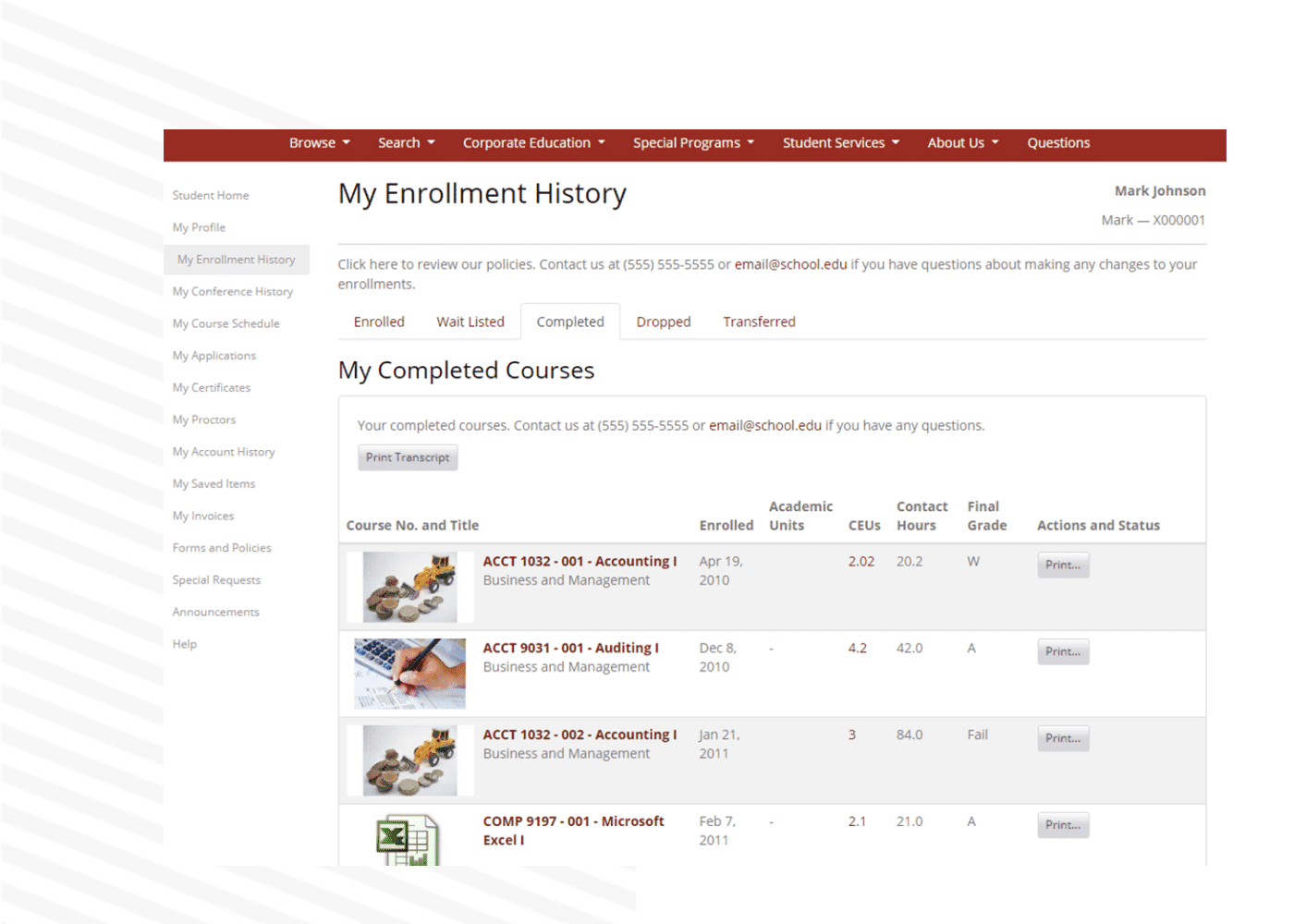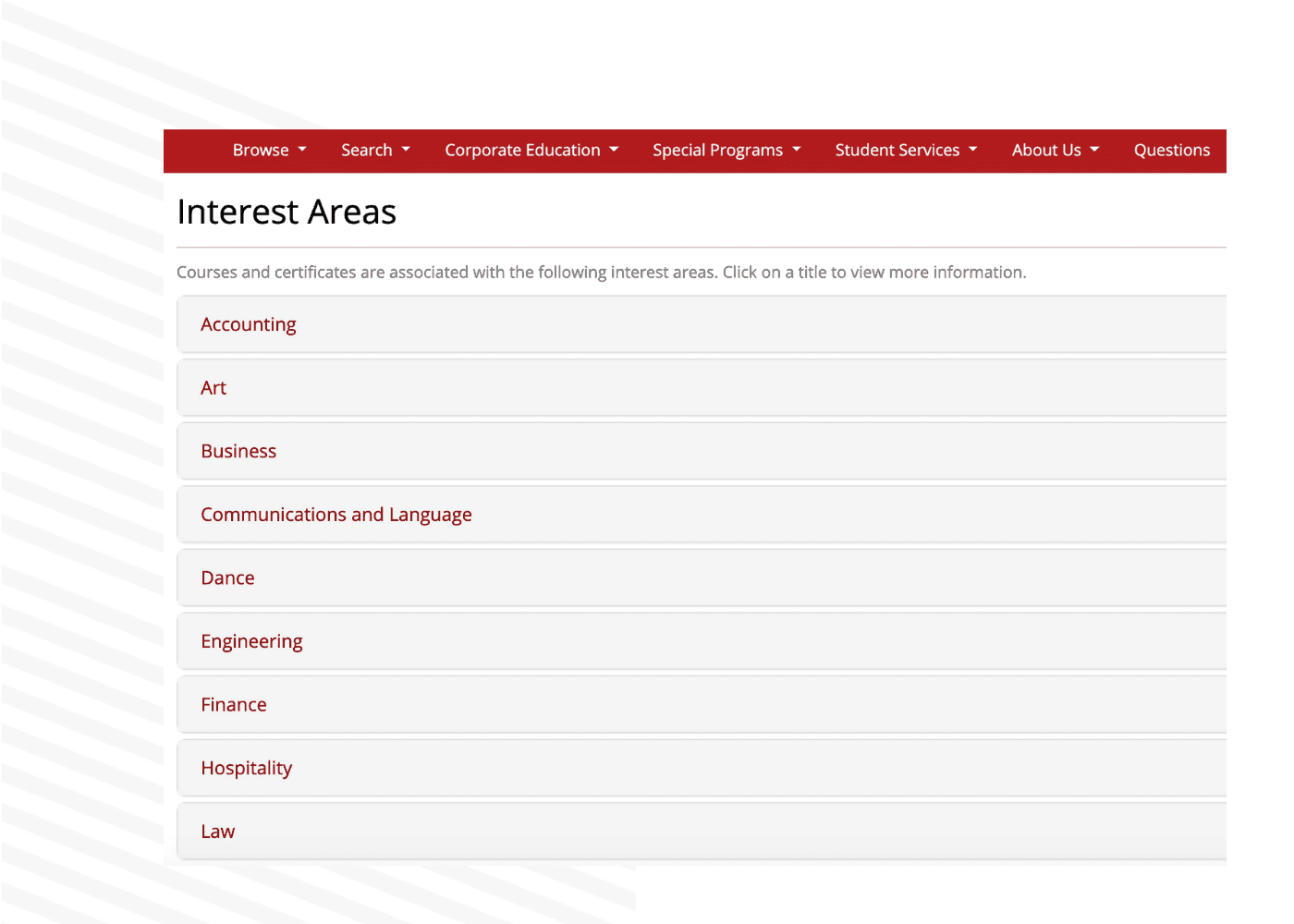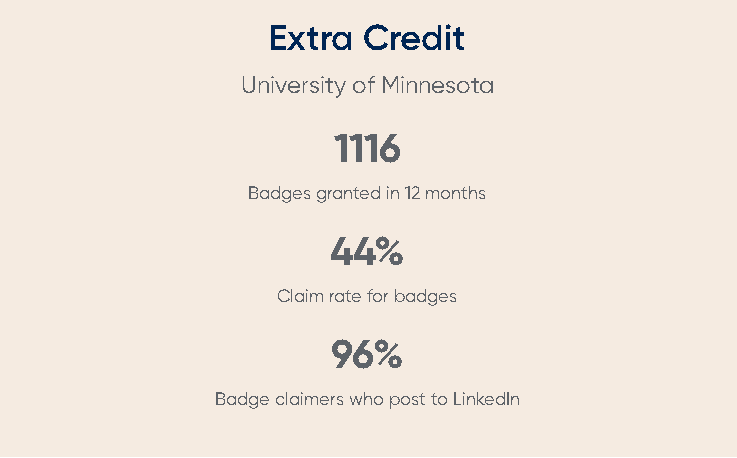Engaging non-traditional learners has become more crucial than ever. These students—working professionals, adult learners, online students and lifelong learners—now represent a significant portion of the student population and require flexible, personalized approaches to education.
A comprehensive student lifecycle management system offers institutions the tools and strategies needed to create meaningful connections with these diverse learners from their first interaction through graduation and beyond. By managing the entire student lifecycle, colleges and universities can transform how they attract, support and retain students throughout their educational journey.
Here are ten essential strategies for creating an effective student lifecycle management approach that addresses the unique needs of non-traditional learners while driving enrollment, improving retention and fostering lifelong engagement.
1. Modernize Your Digital Presence
As higher education evolves, institutions must adapt to meet the needs of diverse student populations. Traditional approaches to student engagement often fall short, particularly for non-traditional learners who require flexible pathways to education. Student lifecycle management helps institutions attract, engage and support students from initial outreach through career advancement.
A student lifecycle management system creates seamless, personalized experiences that drive enrollment, improve retention and enhance long-term student success. With digital tools and lifecycle management solutions, institutions can:
- Offer tailored academic pathways
- Optimize student support services
- Ensure ongoing engagement long after graduation
Modernizing digital presence can significantly enhance student retention by addressing unmet needs and tailoring approaches to individual student circumstances.
From first contact to lifelong learning, institutions need a strategy that aligns with the way modern students navigate education. Explore how colleges and universities can modernize their digital presence, simplify enrollment and drive engagement through an effective student lifecycle management approach. Whether it’s optimizing student recruitment, enhancing retention strategies or supporting alumni, the right system empowers institutions to create a sustainable, student-first experience.
2. Reach Prospects Early

Offer K-12 access
Launch summer camps, dual enrollment courses and enrichment opportunities to bring K-12 students onto your campus. These initiatives introduce students early into the student lifecycle management system, making future transitions seamless.
At this stage, the system helps institutions foster early engagement, ensuring that prospective students are exposed to academic pathways before they even reach higher education. By capturing this audience early, institutions can create a pipeline of engaged learners who are more likely to enroll in future courses, supporting them throughout the student's journey.
Stay active on social media
Social media is a tool not to be ignored for engaging students at every stage of their academic journey. Institutions can leverage CMS plug-ins to automatically distribute content across platforms like Facebook, Twitter and LinkedIn, ensuring consistent communication without requiring manual effort. Automation saves time and keeps students informed about new programs, enrollment deadlines and campus events in real time.
Integrate student engagement strategies that encourage interaction. Features like AI-driven chatbots, interactive Q&A sessions and user-generated content can create a sense of community and drive continuous engagement. By aligning social media efforts with a student lifecycle management system, you can cultivate long-term relationships and ensure students remain connected even after graduation.
Make yourself easy to find
Students rely on search engines to explore educational opportunities, making SEO optimization a must-have component of any lifecycle management solution. To increase your visibility in search results and attract prospective students, ensure that course pages, program descriptions and enrollment information are optimized with relevant keywords, structured metadata and mobile-friendly designs.
To craft a strong digital presence, utilize AI-powered search functionalities, voice search optimization and personalized landing pages that dynamically adjust based on visitor behavior. By integrating these advanced lifecycle management techniques, colleges and universities can enhance discoverability, attract non-traditional learners and create seamless pathways to enrollment.
3. Build a Student-Centric Experience
A modern student lifecycle management approach starts with a student-first experience—one that prioritizes personalized engagement and seamless interactions. Students expect institutions to provide tailored digital experiences that guide them from initial inquiry through enrollment and beyond.
With a lifecycle management solution, institutions can leverage data-driven personalization to deliver relevant content, course recommendations and communication at every touchpoint. By integrating AI-powered insights and student engagement strategies, colleges and universities can connect with prospective students early, ensuring they receive the right information at the right time.
Seamless digital pathways eliminate friction in the student journey. From interactive course catalogs to automated enrollment workflows, a student lifecycle management system makes it easier for students to explore, register and advance their education. A student-first experience fosters meaningful engagement that builds long-term relationships between institutions and learners.
4. Simplify Student Enrollment

Offer seamless registration
Leverage Modern Campus Lifelong Learning’s enhanced registration system to make enrollment frictionless for students. A well-integrated student lifecycle management solution eliminates barriers and improves access to education, ensuring students can easily find, select and enroll in courses that fit their needs.
By simplifying the enrollment process, institutions reduce friction that can deter potential students from completing their registration. Additionally, offering automated course recommendations and pre-filled student data can further streamline the process, reducing dropout rates before classes even begin. A smooth, intuitive registration experience ensures that non-traditional learners feel supported and empowered in their decision to pursue further education.
Simplify career outcomes
With Modern Campus Career Pathways, students can easily understand the career possibilities a particular course or program opens up for them. This feature ensures that lifecycle management solutions provide value beyond the classroom by mapping academic experiences to real-world opportunities.
Career planning tools provide clarity for students, helping them make informed decisions about their educational journey. By integrating career pathways and employer connections into the student lifecycle, institutions can foster long-term engagement and guide learners toward high-demand careers, increasing both student satisfaction and institutional success metrics.
Deliver stackable credentials
Leverage student histories to simplify the registration process, allowing students to progress through stackable credentials without bureaucratic barriers. This approach enhances non-traditional student support by offering clear, incremental learning pathways that align with industry needs.
Stackable credentials ensure that students can build upon previous learning experiences without unnecessary redundancy. Having flexibility caters to lifelong learners who require modular education to align with their evolving career needs. By integrating digital credentialing and automated progress tracking, institutions can keep students engaged and encourage continued learning while providing verifiable achievements that enhance employability.
5. Support Non-Traditional Learners with Lifecycle Management Solutions
Higher ed is no longer a one-size-fits-all journey. A growing number of students are working professionals, adult learners and online students who require flexible, accessible pathways to education. Institutions that embrace student lifecycle management can better serve non-traditional learners, ensuring they receive the support needed to succeed at every stage of their academic journey. Student success initiatives, such as tutoring, advising and adjustments to the learning environment, can further support non-traditional learners by addressing their unique academic progress and personal needs.
A well-designed lifecycle management solution provides:
- Adaptable enrollment options, allowing students to engage in learning at their own pace.
- Features like stackable credentials, modular course structures and alternative credit pathways give non-traditional students the ability to build their education incrementally—without unnecessary barriers.
- Engagement tools and strategies, such as AI-driven recommendations, automated course reminders and personalized career pathways keep students connected and motivated.
Whether through continuing education programs, workforce development initiatives or professional upskilling, a strong student lifecycle management system ensures non-traditional students remain engaged and supported throughout their learning experience.
6. Drive Ongoing Engagement

Help students navigate your website
With robust personalization in our CMS, the website will offer relevant and personalized content to students—right from the homepage. Personalization is a critical component of student engagement strategies.
By offering personalized content, institutions can enhance student satisfaction and retention. The student lifecycle management system ensures that students receive relevant academic recommendations and resources tailored to their unique learning interests.
Give students control
Self-service functionalities built into the student portal allow learners to manage their enrollment and access critical resources without relying on staff. A student-centric experience fosters independence and strengthens non-traditional student support.
When students have autonomy over their academic journey, they are more likely to remain engaged and proactive in their learning. Self-service functionalities reduce administrative bottlenecks and allow institutions to allocate resources more effectively.
Drive student success
Students can track their progress toward credential attainment, and marketing campaigns can inspire them to enroll in the next relevant offering. Continuous engagement ensures a well-supported student lifecycle.
Ongoing support tools ensure that students remain motivated and committed to completing their education. Institutions can leverage predictive analytics to identify at-risk students and proactively intervene to boost retention rates.
7. Make Data-Driven Decisions in Student Lifecycle Management
Effective student lifecycle management demands real-time insights that empower institutions to anticipate student needs and enhance their experiences.
- Predictive analytics identify at-risk students before they disengage. By analyzing behavioral patterns, academic performance and engagement metrics, institutions can proactively intervene with targeted support services, ensuring students stay on track.
- Student engagement data also refines outreach strategies. With a lifecycle management solution, institutions can track how students interact with digital platforms, optimizing communication and course recommendations based on individual interests and behaviors.
By integrating AI-powered automation, institutions can enhance lifecycle management solutions with dynamic course recommendations, automated nudges for important deadlines and customized academic pathways. Adopting intelligent tools ensures that students receive the guidance they need—at the right time—creating a seamless, personalized learning journey that extends beyond the classroom.
8. Create a Digital Experience that Tailors the Website to Each Visitor
Take your website from static to active and ensure it’s delivering the high-quality experience a modern student expects. Harness the Modern Campus Student Engagement Platform to deliver a truly personalized website experience.
- Serve up a customized front page that highlights relevant content depending on visitor browsing patterns.
- Easily set up SEO-optimized landing pages for courses and programs that make it easy for people to find you through search engines.
- Offer advanced search functionalities on your website to help people find exactly what they want with only a few keywords.
Make Your Checkout Experience Seamless
Modern Campus Lifelong Learning offers a next-generation shopping cart experience that goes from responsive to transformative. Maximize your conversion rates with features including:
- Visual shopping cart
- Automated waitlist notifications and course launch emails
- Save-for-later functionality
- Batch enrollment capabilities
- Abandoned shopping cart recovery
- Next-generation payment options
An optimized checkout process removes unnecessary friction, making it easier for students to complete transactions and enroll in their desired programs. A streamlined payment experience improves conversion rates and ensures students can seamlessly progress in their learning journey.

9. Create Opportunities for Students to Stay Engaged
Lifelong learning is a reality for today’s working professionals, and the Modern Campus Student Engagement Platform is designed to keep individuals coming back forever.
Let students track their certificate progress and easily see what courses they need to earn critical credentials. You can even leverage certificate completion prompts that motivate students to keep going.
Provide further encouragement by awarding digital completion badges students can share on their networks, thus transforming them into marketers without you lifting a finger. (We’ve had customers increase page traffic 15 times this way!)

Strengthen Alumni Engagement for Long-Term Success
The student lifecycle doesn’t end at graduation—it evolves into an opportunity for ongoing engagement and lifelong learning. Alumni are a vital part of an institution’s success, serving as mentors, recruiters and advocates. An effective student lifecycle management system ensures that alumni remain actively connected, fostering a network that benefits both graduates and current students.
- Institutions can provide tailored career services, professional development opportunities and exclusive networking events that keep alumni engaged.
- Automated engagement tools allow colleges and universities to send personalized content, such as job opportunities, skill-building courses and invitations to mentorship programs.
- Encouraging alumni to continue their educational journey through continuing education and workforce development programs strengthens institutional ties while supporting lifelong learning.
- Digital student engagement strategies, such as AI-driven career recommendations and alumni-exclusive credentialing opportunities, ensure that graduates see the institution as a long-term partner in their success.
A strong alumni network ensures that students remain connected well beyond their initial academic journey.

10. Offer a Consistent Student Experience
Every institution has numerous faculties, divisions and departments that often operate independently. However, students get confused when their experience is inconsistent.
Give students the consistent experience they crave by leveraging our simplified APIs to integrate the Modern Campus platform into your CRM, your main campus SIS, your LMS, your payment processor and more. These integrations enhance lifecycle management solutions by ensuring a unified and streamlined approach across all touchpoints.
Maintaining a consistent digital experience allows institutions to enhance student trust and satisfaction. A cohesive student lifecycle management system ensures that students can easily transition between different phases of their education without unnecessary hurdles.

By modernizing digital engagement, simplifying enrollment and delivering personalized experiences, institutions can enhance student lifecycle management and empower learners for long-term success.
“With the adoption of Lifelong Learning and the enhancements we’ve made, we’re really starting to see our marketing conversion rates go way up.""
Fred Anger, Executive Director of Financial Planning and Strategy - G. Raymond Chang School of Continuing Education, Ryerson University
Serve Students for Life
Engage students not just for two or four years but for 60. Your relationships with students can start in childhood, extend across their careers and into retirement.
Leverage the Modern Campus Student Engagement Platform to deliver the experience they want at every touchpoint!